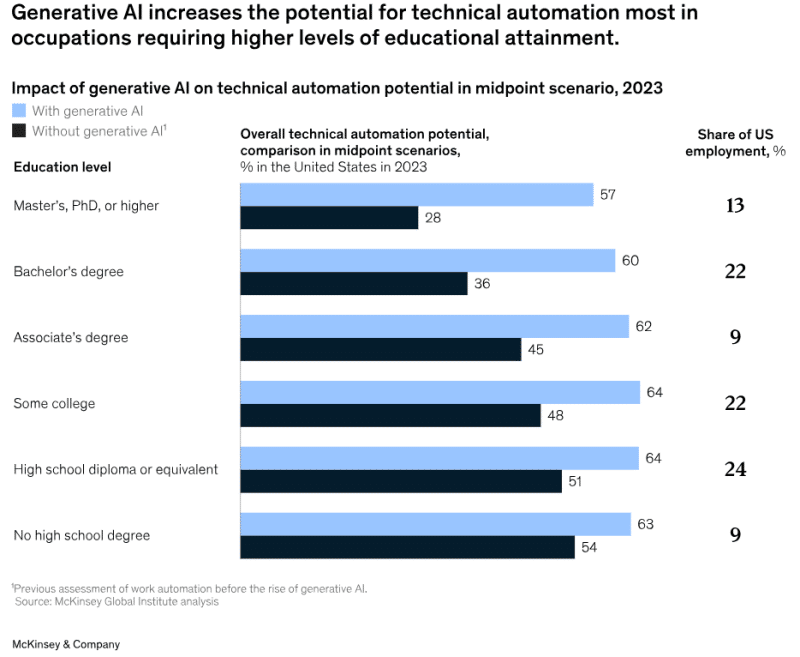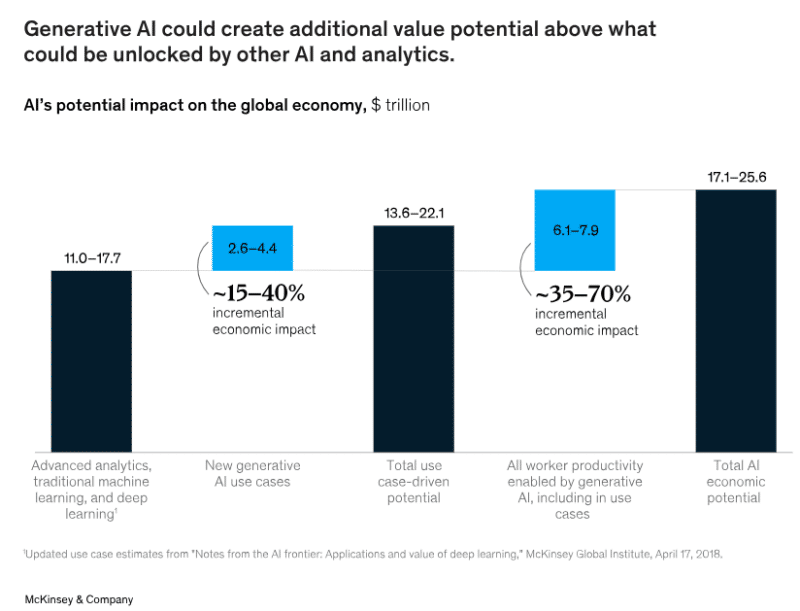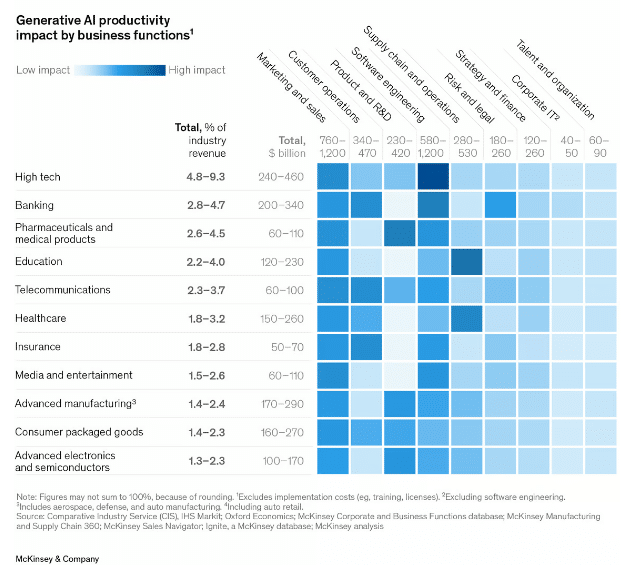Why highly educated workers are more likely to be replaced by generative AI?
McKinsey, a leading consulting firm, released a study on June 14, 2023 titled "The
economic potential of generative AI". By studying 850 occupations in 47 countries
and regions, the report explores the impact of the rapid development of AI on the
global economy and focuses on which industries will face impact and which groups
will face career adjustments. In this article, we will interpret some of the key
findings of this report with data.
1. AIGC may accelerate the
structural transformation of the labor force
According to the
general view in the field of labor economics, the deployment of automation
technologies tends to have the greatest impact on the workforce with the lowest
skill levels. But this McKinsey report finds that the deployment of Artificial
Intelligence Generated Content (AIGC) will bring about the opposite: that AIGC will
need to have the greatest incremental impact by automating more highly skilled jobs.
This means a more educated workforce will be more impacted.

According to McKinsey's explanation, the spread of AIGC is still skill-oriented
technological change, but it brings with it more refined skills that are more likely
to be directly replaced by machine-performable activities, rather than supplemented.
The impact of AIGC could dramatically change the jobs of highly paid
knowledge workers, as the potential for technological automation of these jobs
continues to rise.
Extrapolating from this outlook, a portion of the labor
force will continue to work in their current occupations, but with a change in
job-related activities or skill sets; a portion of the labor force will need to
switch occupations and move to positions that better match their job skills.
This does not mean, however, that industries will be hit by labor
restructuring. According to the analysis of other dimensions in this McKinsey
report, AIGC will play a not insignificant role in productivity improvement in
various fields and industries.
2. AIGC will contribute trillions of
dollars to the global economy
McKinsey uses two complementary
perspectives to project how much value AIGC could create with its current
capabilities.
The first lens is the use cases for AIGC. Use cases are
scenarios in which an organization uses AIGC to conduct business in a way that
produces quantifiable results, such as using AIGC in marketing to create
personalized emails that increase revenue by reducing costs and increasing
efficiency. McKinsey examined 63 AIGC use cases covering 16 business functions and
calculated that in cross-industry application scenarios, these use cases could
create $2.6 trillion to $4.4 trillion in annual economic benefits.
The
second perspective is the potential impact of AIGC on jobs. McKinsey modeled various
scenarios to project when AIGC would be able to perform each of the "detailed work
activities" required for different occupations in the global economy, such as
"communicating with others about operational plans or activities" to assess how AIGC
might affect the labor productivity of the global workforce.
Given that some
of the impacts in the second perspective overlap with the cost reductions in the
first, removing this overlap results in total economic benefits from AIGC of between
$6.1 trillion and $7.9 trillion per year.

3. Business functions with the highest value of AIGC applications
Based on the functionality and importance of AIGC use cases, as well as the
size of industry revenues, McKinsey estimated the application value of different
AIGC business functions in different industries. The business functions with the
highest application value include marketing and sales, customer operations, software
engineering, and research and development. The highest-value marketing and sales
functions are estimated to create a total of $760 billion to $1,200 billion in value
across a wide range of industries.
AIGC's key value-creating functions vary
widely by industry. For example, in the retail industry, according to McKinsey's
analysis, AIGC could contribute about $310 billion in additional value to the retail
industry (including auto dealerships) by improving performance in marketing,
customer relations, and other areas. And the high-tech industry derives much of its
potential value from AIGC's ability to improve the speed and efficiency of software
development.

4 Industries most affected by AIGC
Based on McKinsey's
calculated values in the chart above, the industries that will be most affected by
AIGC will be the high-tech industry, the banking industry, and the pharmaceutical
and healthcare industries.
The high-tech industry is expected to be the most
impacted by the AIGC, with the value created by the AIGC ranging from 4.8% to 9.3%
of the industry's annual revenue, or $240 billion to $460 billion. One of the
strongest value-added business functions is software engineering.
Next in
line is the banking industry. Banking is a knowledge- and technology-driven
industry. The value created by AIGC through productivity improvements can account
for between 2.8 percent and 4.7 percent of the banking industry's annual revenue, or
$200 billion to $340 billion. In addition, the use of AIGC technology can increase
customer satisfaction, improve decision-making and employee experience, and reduce
risk by better monitoring fraud.
In third place is the pharmaceutical and
healthcare industry. In this industry, the value created by AIGC can account for
2.6% to 4.5% of annual industry revenue, or $60 billion to $110 billion per year.
Pharmaceutical companies typically spend about 20 percent of their revenues on
research and development (R&D), with the development of a new drug taking an average
of 10 to 15 years. Utilizing AIGC technology can increase the speed and quality of
R&D and generate tremendous value. For example, the identification of certain
molecules in the pharmaceutical process can take months using "traditional" deep
learning techniques, while it can be accomplished in a matter of weeks using large
models and AIGC.